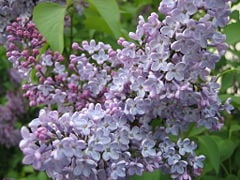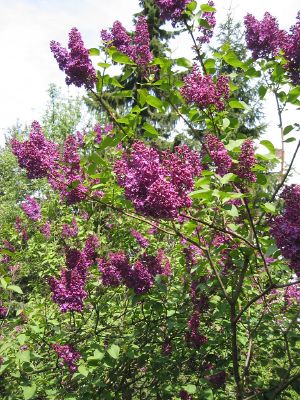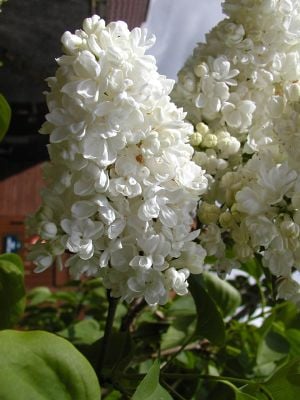Syringa
- The unrelated but somewhat similar-looking Chinaberry (Melia azedarach) is sometimes called "lilac" too.
- About the color see Lilac (color).
| Syringa | ||||||||||||
|---|---|---|---|---|---|---|---|---|---|---|---|---|
 Syringa vulgaris (Common Lilac) flowers
| ||||||||||||
| Scientific classification | ||||||||||||
| ||||||||||||
|
About 20 species; see text. |
Syringa (Lilac) is a genus of about 20–25 species of flowering plants in the olive family (Oleaceae), native to Europe and Asia.[1][2][3][4]
They are deciduous shrubs or small trees, ranging in size from 2–10 m tall, with stems up to 20–30 cm diameter. The leaves are opposite (occasionally in whorls of three) in arrangement, and their shape is simple and heart-shaped to broad lanceolate in most species, but pinnate in a few species (e.g. S. protolaciniata, S. pinnatifolia). The flowers are produced in spring, each flower being 5–10 mm in diameter with a four-lobed corolla, the corolla tube narrow, 5–20 mm long; they are A-sexual, with fertile stamens and stigma in each flower. The usual flower colour is a shade of purple (often a light purple or lilac), but white and pale pink are also found. The flowers grow in large panicles, and in several species have a strong fragrance. Flowering varies between mid spring to early summer, depending on the species. The fruit is a dry, brown capsule, splitting in two at maturity to release the two winged seeds.[2][3][4][5]
The genus is most closely related to Ligustrum (privet), classified with it in Oleaceae tribus Oleeae subtribus Ligustrinae.[6]
Lilacs are used as food plants by the larvae of some Lepidoptera species including Copper Underwing, Scalloped Oak and Svensson's Copper Underwing.
Species
|
|
Cultivation and uses
Lilacs are popular shrubs in parks and gardens throughout the temperate zone. In addition to the species listed above, several hybrids and numerous cultivars have been developed. The term French lilac is often used to refer to modern double-flowered cultivars, thanks to the work of prolific breeder Victor Lemoine.
Lilacs flower on old wood, and produce more flowers if unpruned. If pruned, the plant responds by producing fast-growing young vegetative growth with no flowers, in an attempt to restore the removed branches; a pruned lilac often produces few or no flowers for one to five or more years, before the new growth matures sufficiently to start flowering. Unpruned lilacs flower reliably every year. Despite this, a common fallacy holds that lilacs should be pruned regularly. If pruning is required, it should be done right after flowering is finished, before next year's flower buds are formed. Lilacs generally grow better in slightly alkaline soil.
Lilac bushes can be prone to powdery mildew disease, which is caused by poor air circulation.
The wood of lilac is close-grained, diffuse-porous, extremely hard and one of the densest in Europe. The sapwood is typically cream-coloured and the heartwood has various shades of brown and purple. Lilac wood has traditionally been used for engraving, musical instruments, knife handles etc. When drying, the wood has a tendency to be encurved as a twisted material, and to split into narrow sticks. The wood of Common Lilac is even harder than for example that of Syringa josikaea.
Etymology
The genus name Syringa is derived from syrinx meaning a hollow tube or pipe, and refers to the broad pith in the shoots in some species, easily hollowed out to make reed pipes and flutes in early history.[5][7]
A pale purple colour is generally known as lilac after the flower.
Symbolism
Purple lilacs symbolize first love and white lilacs youthful innocence (see Language of flowers). In Greece, Lebanon, and Cyprus, the lilac is strongly associated with Eastertime because it flowers around that time; it is consequently called paschalia.
Syringa vulgaris is the state flower of New Hampshire, because it "is symbolic of that hardy character of the men and women of the Granite State" (New Hampshire Revised Statute Annotated (RSA) 3:5).
Numerous locations around North America hold yearly Lilac Festivals, the longest-running of which is the one in Rochester, New York. Rochester's Lilac Festival held at Highland Park has the most varieties of lilacs at any single place and many of the lilacs were developed in Rochester.
ReferencesISBN links support NWE through referral fees
- ↑ 1.0 1.1 Flora Europaea: Syringa
- ↑ 2.0 2.1 2.2 Flora of China: Syringa
- ↑ 3.0 3.1 3.2 Flora of Pakistan: Syringa
- ↑ 4.0 4.1 4.2 Germplasm Resources Information Network: Syringa
- ↑ 5.0 5.1 Huxley, A., ed. (1992). New RHS Dictionary of Gardening. Macmillan ISBN 0-333-47494-5.
- ↑ University of Oxford, Oleaceae information site: New classification of the Oleaceae
- ↑ Vedel, H., & Lange, J. (1960). Trees and Bushes in Wood and Hedgerow. Metheun & Co. Ltd., London.
Credits
New World Encyclopedia writers and editors rewrote and completed the Wikipedia article in accordance with New World Encyclopedia standards. This article abides by terms of the Creative Commons CC-by-sa 3.0 License (CC-by-sa), which may be used and disseminated with proper attribution. Credit is due under the terms of this license that can reference both the New World Encyclopedia contributors and the selfless volunteer contributors of the Wikimedia Foundation. To cite this article click here for a list of acceptable citing formats.The history of earlier contributions by wikipedians is accessible to researchers here:
The history of this article since it was imported to New World Encyclopedia:
Note: Some restrictions may apply to use of individual images which are separately licensed.






